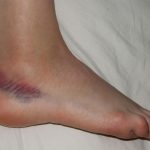 To twist a ligament or muscle of a joint without dislocating the bone.
To twist a ligament or muscle of a joint without dislocating the bone.
Wrenching or twisting of a joint in which ligaments are stretched past their normal limits.
A sprain is an injury to a ligament—a stretching or a tearing. One or more ligaments can be injured during a sprain.
An injury to ligaments, tendons, or muscles by hyperextension or stretching.
A condition in which the ligaments in a joint are stretched or torn because of a sudden movement.
A partial tearing of a ligament.
Injury to ligaments around a joint, causing pain, swelling, and skin discoloration. The severity of symptoms and degree of immobility depend on the site of injury and extent of damage of tissues. Treatment includes support, rest, and cold compresses at the time of injury.
Overstretching or tearing of a ligament; treated by rest, immobilization, or surgery to repair the ligament.
A forcible wrenching or twisting of a joint that may involve severe stretching or tearing of attached ligaments. A sprain does not involve dislocation of the joint, but may cause injury to surrounding blood vessels, muscles, tendons, or nerves. Sprains generally produce significant swelling and pain, as well as bruising if blood vessels are ruptured. The pain may prevent joint movement. Sprains are treated initially by rice (rest, ice, compression, and elevation). After the pain subsides, exercises are prescribed to regain function.
Injury to a ligament, caused by sudden overstretching. As the ligament is not severed it gradually heals, but this may take several months. Sprains should be treated by cold compresses (ice-packs) at the time of injury, and later by restriction of activity.
Injuries in the neighbourhood of joints, consisting usually in tearing of a ligament with effusion of blood.
Trauma to ligaments that causes pain and disability, depending on the degree of injury to the ligaments. In the most severe sprain, ligaments are completely torn. The ankle joint is the most often sprained.
Sprain is a partial or complete tear of a ligament. Both ankles and knees are vulnerable to sprains because of the sudden force or twisting motion that these joints often endure.
An injury in which the ligaments in a joint are stretched too far or are torn.
Tearing or stretching of the joints that causes mild to severe damage to the ligaments and joint capsules.
An injury that occurs when ligaments or tendons near a joint are torn or stretched.
A sprain occurs when the ligaments that connect the ends of bones in a joint are suddenly pulled, causing them to stretch or tear. The ankle is the joint most frequently affected. Symptoms of a sprain include painful swelling and limited joint movement that exacerbates the pain. Muscle spasms around the affected area may also occur.
Treatment typically involves applying an ice pack to the affected area, securing the joint with a bandage, elevating it, and taking pain-relieving medications. For more severe sprains, surgical intervention may be required.
The straining or twisting of a joint. Even a medical professional cannot determine through a cursory examination whether a sprain is accompanied by a fracture. Therefore, it is advisable to approach all sprains with the assumption of a potential fracture until an X-ray examination is conducted. Initial first-aid measures involve applying cold compresses and immobilizing the affected area.
